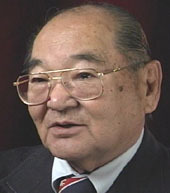
|
||
 Enlarge
Enlarge
|
Licensing | |
To view video, Click Here. Paul B. discusses his first impressions of Manzanar and the struggle to remain positive in a bleak situation.
"When I went there my folks were already there. And these barracks -- I think there were four rooms, and we had one of them. Our whole family was in that one room. I remember the meals. We were in a, lined up and got our little meal in the mess hall there. I remember that we had to go take a shower and clean up in a common bathroom. All these things were things that I don't think any of us was ever used to. And although when I went there, I was given a very good job and had an office to go to and things, it was still the mere fact that I was confined. I couldn't go out to anywhere, couldn't do what I wanted to do. And it was taken away, the rights that I felt that I, as an American citizen I should have. But I remember though, that because of the camp and the people saying, "Well, we're going to be here, let's make the best of it," that there was activities such as sports activities, social gatherings. I never went to any dances or anything like that, but I know that they had those things set up, and to, you might say, keep the morale of the population in camp up, which was good. You had to do that, otherwise it was a very depressing situation."
Paul B. Interview - Copyright © 2000 Densho. All Rights Reserved.
Nisei male. Born July 4, 1920 in Delta, Colorado. Grew up in small mining and farming towns in Colorado, Utah and Arizona, until his family moved to Boyle Heights in the Los Angeles, California area. After graduating from high school, he tested discrimination and employment practices and eventually succeeded in obtaining a job at a bank. During World War II, his family was held in Manzanar incarceration camp, California. Joined the 442nd Regimental Combat Team, and was later transferred to the U.S. Military Intelligence Service. He served in New Guinea and elsewhere overseas, was an interpreter for the Allied Translator and Interpreter Service (ATIS), and interpreted at the surrender of Japanese forces at ceremonies in Indonesia. Married and eventually resettled in Gardena, California, where he worked in the floral industry before founding his own company. An extremely active community and civic volunteer, he joined the Elks Club as well as many veterans' and other organizations. He was elected to the Gardena city council in 1972, and in 1973 was elected to the California State Legislature. In 1980, he became the executive director of the Commission on Wartime Relocation and Internment of Civilians (CWRIC). In 1981, he was appointed chief director of the Memorial Affairs Department of the Veterans Administration by President Ronald Reagan.
Courtesy of Densho: The Japanese American Legacy Project
 densho
—
Atualizado em Out 29 2019 3:16 p.m.
densho
—
Atualizado em Out 29 2019 3:16 p.m.
Part of these albums

|
Voices from the Camps densho
densho
|

|

 Voices from the Camps
Voices from the Camps
 Journal feed
Journal feed
